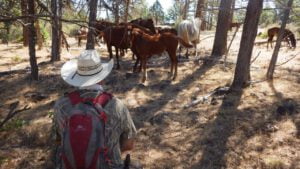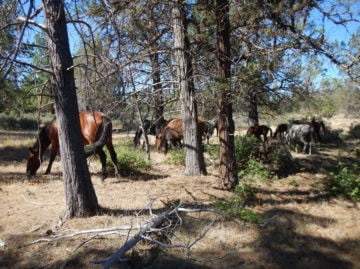
You’ll never hear the Bureau Of Land Management mentioning any of the following:
Q2 2020 hedge fund letters, conferences and more
There are some American small towns whose local economies are boosted annually off Ecotourism using native species American wild horses….
One example was written-up here: https://www.craigdailypress.com/news/survey-moffat-countys-economy-boosted-by-wild-horses/
BLM Removing Wild Horses From The Landscape
Towns and the public have been, and continue to be, bamboozled by the Bureau of Land Management (‘BLM’) in regard to wild horses just so the BLM can continue to get rich off taxpayer dollars (to the tune of $100-Million/year) by monetizing the roundups and warehousing of the dwindling population of native-species American wild horses! [1]
Making matters even worse is that the BLM is removing these large herbivores (wild horses) from the landscape at a time when fuel-choked wilderness and rural areas are severely depleted of the herbivores (deer, wild horses, buffalo) that had evolved consuming excessive wildfire fuels. This is an undeniable science fact [2] [3] [4}.
In some cases, the BLM pays ranchers (allegedly their pals in some cases) to warehouse American wild horses on private ranch lands that are so poor in carrying capacity, they’re useless for livestock production! So those ranchers go into the lucrative wild horse warehousing business. And American taxpayers foot the bill for this insanity and what ends up as a form of abuse, since wild horses that are doomed to such sparse grazing areas end up hungry and in some instances, without adequate water.
Furthermore, there is no census or proper audit performed by an unbiased third party on all the BLM’s warehoused wild horses, and given the American public is charged on a per-horse basis, nobody really knows if taxpayers are getting screwed there too!
It’s been alleged that after a year or two out on the warehouse ranges, some wild horses go missing and it’s alleged they end-up at slaughter houses, further enriching some unscrupulous ranchers like Ken Salazar (former head of Dept. of the Interior and the BLM) and his rancher buddy and neighbor Tom Davis; The GAO cited this crime (‘conversion’) for which nobody was punished… Here is the published article at the HuffPost: https://www.huffpost.com/entry/inspector-general-report_b_8393670
Meantime, it is alleged that taxpayers are still paying for horses to be warehoused that have long since left their sad existence under the boots of the cruel masters at the BLM…
How long shall the American public sit-still and take the screwing that’s being dished out by the Department of Interior’s BLM? How long shall good Americans standby and watch this abuse and mismanagement of American icons, which are supposed to be ‘protected’ by a Congressional Act?
Making Money Via Ecotourism
On a brighter note; there is a genuine long-term sustainable solution for American wild horses, that makes money via ecotourism, benefits multiple stakeholders including the livestock and forest industries, and also helps reduce wildfires!
The International Ecotourism Society published the following story:
We need to move past wildfire mitigation plans based-on failed concepts and more guess-work by the same people behind what clearly doesn’t work, and politics.
We need to move into the realm of wilderness and forest management plans that are weighted heavily on natural prevention, and are based solely in science that is empirically proven and that cost-effective (actually makes a profit for taxpayers), which by-the-way exists right now!
Wildfire prevention
This study titled “Impact Of Wild Horses On Wilderness Landscape And Wildfire – Preliminary Findings” by naturalist-rancher William E. Simpson II unveils a factual understanding of wild horses and their natural, positive impact on wilderness and forest landscapes.

Wild horses reducing dry fuels off forest floor.
One of the main outcomes of this study is that wild horses could have a major impact on reducing fire damage, by their specific way of grazing, locally taking out large volumes of fuel, and thereby creating landscapes that are less vulnerable for large scale wildfires.
We cannot control the climate or the behavior of careless people. We can control the fine fuels (grass and brush) are the KEY fuels in all catastrophic level wildfires. And that is accomplished by using a mixed herbviory plan, which involves the appropriate allocation of species of herbivores across the American landscape into economically and ecologically appropriate areas.
A related article was recently published at ZeroHedge and ValueWalk: https://www.valuewalk.com/2020/09/reduce-catastrophic-wildfires/
[1] The U.S. Ninth Circuit Court of Appeals in California recognized wild horses as native species, explaining that BLM “establishes Appropriate Management Levels (“AMLs”) for populations of native species – including wild horses, burros, and other wildlife – and introduced animals, such as livestock.” In Defense of Animals, et al. v. U.S. Dept. Interior, et al., No. 12-17804, *6 (9th Cir. May 12, 2014). On Sep 28, 2011 (See Craters AR at 16698. Memorandum Decision & Order) The court addresses “sensitive” species pursuant to BLM’s 2001 Special Status Species Policy. This Policy requires that “sensitive” species be afforded, at a minimum, the same protections as candidate species for listing under the ESA. It called on BLM managers to “obtain and use the best available information deemed necessary to evaluate the status of special status species in areas affected by land use plans . . . .” See Policy at § 6840.22A. Under the Policy, those land use plans “shall be sufficiently detailed to identify and resolve significant land use conflicts with special status species without deferring conflict resolution to implementation-level planning.”
[2] Collapse of the world’s largest herbivores: “By altering the quantity and distribution of fuel supplies, large herbivores can shape the frequency, intensity, and spatial distribution of fires across a landscape”. William J. Ripple1, Thomas M. Newsome1,2,Christopher Wolf1, Rodolfo Dirzo3, Kristoffer T. Everatt4, Mauro Galetti5, Matt W. Hayward4,6, Graham I. H. Kerley4, Taal Levi7, Peter A. Lindsey8,9, David W. Macdonald10, Yadvinder Malhi11, Luke E. Painter7, Christopher J. Sandom10, John Terborgh12 and Blaire Van Valkenburgh13 http://advances.sciencemag.org/content/1/4/e1400103.full
[3] Rewilding: Jozef Keulartz. “The removal of large herbivores has adverse effects on landscape structure and ecosystem functioning. In wetter ecosystems, the loss of large herbivores is associated with an increased abundance of woody plants and the development of a closed-canopy vegetation. In drier ecosystems, reductions of large grazers can lead to a high grass biomass, and thus, to an increase in the frequency and intensity of wildfires. Together, with the loss of a prey base for large carnivores, these changes in vegetation structures and fire regimes may trigger cascades of extinctions (Bakker et al., 2016; Estes et al., 2011; Hopcraft, Olff, & Sinclair, 2009; Malhi et al., 2016).” http://oxfordre.com/environmentalscience/view/10.1093/acrefore/9780199389414.001.0001/acrefore-9780199389414-e-545
[4] Capt. William E. Simpson II – Naturalist, has over the past 5-years compiled and published research and scientific data, both academic and empirical in nature, that support a wildfire reduction plan and *Study, as well as legal vehicles to implement it. For example, under present law, wild horses and burros can be transferred to Federal, state or county agencies as “work” animals: https://www.aila.org/infonet/house-bill-consolidated-appropriations-act-2018 – H.R. 1625-313 (Humane transfer of excess animals, Sec. 113.
*Impact Of Wild Horses On Wilderness Landscape And Wildfire (https://pitchstonewaters.com/wild-horse-fire-brigade-lessons-in-rebalancing-north-american-ecosystems-by-rewilding-equids/)
More information, news coverage, documentary videos, and draft legislative outline here: www.WHFB.us
#Wild Horses, #WildFire, #California Wildfires, #Oregon Wildfires, #White House, #Congress, #Economy
The post Profiting From Ecotourism – Town’s Economy Boosted By Wild Horses! appeared first on ValueWalk.
